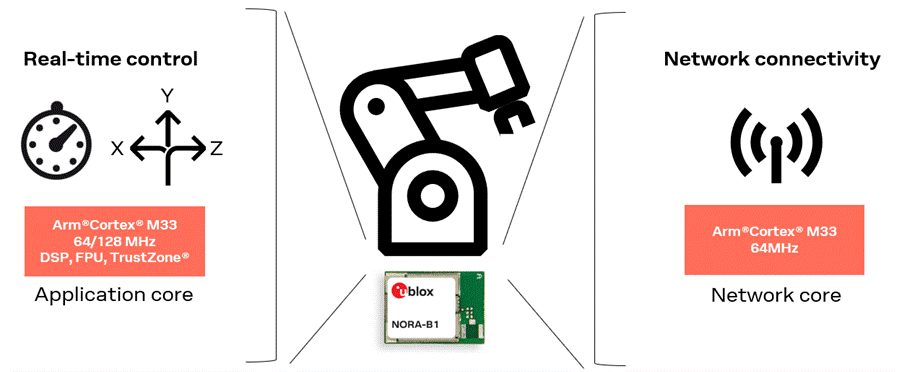When it comes to your connected devices, you, like most people, probably want to have your cake and eat it. Let me guess: you’d like devices to improve on all fronts from one generation to the next, becoming more powerful and power efficient, easier to use, and quicker to respond. Of course, you expect them grow their list of features to enable ever more, and more sophisticated, use cases. And, amid all this technological progress, you expect them to be more tightly integrated, fitting into ever smaller end devices.
It’s tough to keep with these demands, and tougher still to stay ahead of the game. But with their nRF5340 dual core Bluetooth system-on-chip, Nordic Semiconductor has brought the industry a compelling solution to this challenge. Featuring two Arm Cortex-M33 processors – a high performance application core that works in tandem with a low-power network core – the chip’s dual core MCU takes Bluetooth hardware performance to the next level, paving the way for new, more complex solutions.
We integrated the nRF5340 into the u‑blox NORA-B1 stand-alone Bluetooth 5.2 module, to give device developers easy access to all its features and processing power. If past is prologue, we’ll have to wait to discover the myriad ways they find to get the most out of the module’s capabilities. But looking into the crystal ball, here are some use cases that we are anticipating.
Eliminating interference: Connected power tools
Connected power tools are becoming more and more common on construction sites. Typically featuring Bluetooth technology, they offer site managers a way to locate their tools, track their use, and assign and configure them to individual workers.
In many of today’s power tools such as drills, the motor is controlled by an application that translates the trigger’s position to a drilling speed, with tough real-time requirements. Even small delays between squeezing the trigger and adjusting the drilling speed can make the power tools difficult to work with. To avoid such “jitter,” today’s power tool manufacturers typically run the application controller and the network controller on two separate MCUs to avoid any interference between the two.
NORA-B1’s dual core MCU decouples network and application control on a single component, with the nRF5340’s application core controlling the application and its network core running the Bluetooth stack. This lets solutions dedicate the required resources to each task, reduce BOM size and cost, and deliver smooth, jitter-free performance.
Driving complex GUIs: Connected medical wearables
NORA-B1’s dual core architecture also has the potential to level-up the performance of medical wearables, used, for example, to monitor patients both in the clinic and at home. In the early days of Bluetooth-enabled medical wearables, device manufacturers were forced to split up application and network control using two separate MCUs.
Then, as MCUs became more powerful, they saw an opportunity to reduce the cost and size of their end devices with little impact on performance by moving to a single MCU solution. Today, these are being pushed to their limits by increasing computational demands from more sophisticated graphical user interfaces (GUIs) that patients, accustomed to state-of-the-art smartphones and smart watches, have come to expect.
With the NORA-B1’s, developers of medical wearables will get the computational power they need to drive more complex GUIs, control their applications, and run the Bluetooth stack on roughly the same footprint as today’s devices, without skipping a beat. And let’s not forget to mention the module’s high-speed SPI interface, essential to driving the display.
Tighter integration: Smaller sensors with edge intelligence
Developers of smart sensor with edge intelligence, such as those used for predictive maintenance, will also be able to capitalize on NORA-B1’s increased computing power and integration. Rather than transmitting a constant stream of data to the cloud for processing and analysis, these devices increasingly run algorithms that pre-process the sensed data before it is sent to the cloud for analysis.
The result is a predictive maintenance sensor with minimal bandwidth requirements, short latency, and a shorter bill of materials, with enough CPU power to run the complex algorithms the use case requires.
Ultra-low power: Running applications on the network core
NORA-B1’s power-efficient network core was designed to handle the Bluetooth stack and networking activities. That said, it has some extra capacity that product developers can leverage to develop ultra-low-power applications.
Consider smart sensors in which a powerful application processor only rarely needs to step in, for example, when triggered by incoming messages or external events. In such cases, the network core can run the show most of the time while the application processor remains dormant in a low-power sleep mode.
Sure, you could simply use a single high-performance core to run the sensor, the Bluetooth stack, and the application. But you’d constantly have to power an MCU that was optimized for performance, not for power efficiency. By decoupling the low-power networking core from the high-performance application core, the dual core MCU again combines the best of both worlds: ultra-low power most of the time, and high-performance when needed.











